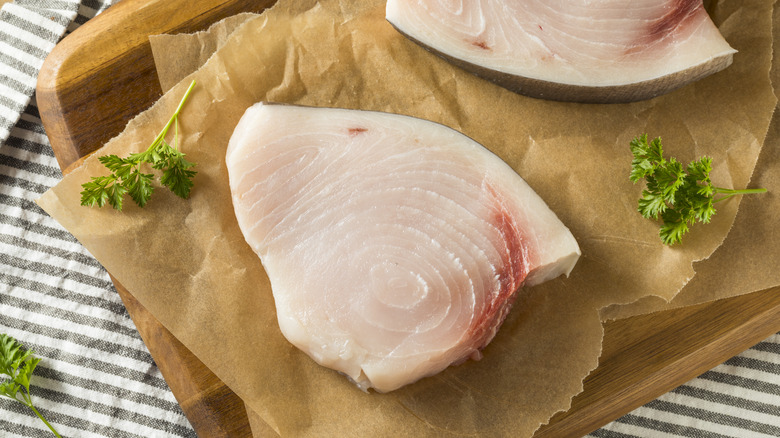The Disturbing Reason Anthony Bourdain Said To Skip Eating Swordfish
Among many things, Anthony Bourdain's magnum opus "Kitchen Confidential: Adventures in the Culinary Underbelly" was a shocking exposé of the more unsavory industry practices that happen behind the scenes in restaurants. As the former executive chef at Les Halles Brasserie in Manhattan, Bourdain revealed that things can (and often do) get a little nasty even in the fine dining world.
At many upscale seafood establishments, folks are ordering swordfish, favored for its large, meaty, steak-like filets with few bones compared to other fish. During peak season (August through October), fresh swordfish filets cost chefs $14 to $30 per pound — a price that becomes much higher for restaurant guests. It can be sautéed, grilled, and poached, but one of the most common preparations for swordfish is raw in sushi and sashimi. That's bad news, considering Bourdain's advice, which is: Watch out for swordfish worms.
"[S]wordfish? I like it fine," he wrote. "But my seafood purveyor, when he goes out to dinner, won't eat it. He's seen too many of those three-foot-long parasitic worms that riddle the fish's flesh. You see a few of these babies — and we all do — and you won't be tucking into swordfish anytime soon."
Worms (enough said)
These swordfish worms are a type of nematode called ascarids, which are related to the parasite that causes trichinosis. Farmed fish have a lower chance of contracting parasites than fish in the wild, but swordfish are seldom farmed. Ascarids begin infesting the swordfish's flesh shortly after it dies, and once they do, it's virtually impossible to get rid of them. They can be killed if the fish is cooked to 145 degrees Fahrenheit for 15 seconds (which would dry out the delicate fillet) or by freezing the meat to -4 degrees for a week (which would also ruin the fillet). If you're chowing down on that swordfish raw, it's best to order the "leap of faith" fish as an appetizer. The best-case scenario for an infested fish is that the worms are killed, but they'll still be in the meat.
It's not just about the worms, either. In a 20-year FDA test of 68 types of fish and shellfish, swordfish clocked in at second place for the highest levels of mercury. A separate study published in Environmental Health Perspectives reported that high-end fish consumers discovered swordfish consumption had the highest correlation with elevated blood mercury levels. Due to its high mercury content, the FDA advises children and pregnant people to avoid eating the swordfish altogether. So, diehard, undeterred seafood fans, give your swordfish a good inspection before handling it in the kitchen. Pale to pink flesh with vivid red bloodlines is a good sign of quality.

